
|
It returns for the first time in 70 years. It brightened up to 3.7 mag in early April (Apr. 6, Jose Guilherme Aguiar). Now it is 6.7 mag (June 1, Marco Goiato). Fading rapidly. In the Northern Hemisphere, it is not observable now. It locates somewhat low in the Southern Hemisphere. But it will become high in winter.
Date(TT) R.A. (2000) Decl. Delta r Elong. m1 Best Time(A, h)
June 1 5 47.37 -18 40.2 1.546 1.083 44 6.4 20:52 ( 88,-32)
June 8 6 14.30 -23 12.2 1.549 1.170 49 6.9 20:58 ( 84,-35)
|

|
It returned for the first time in 68 years. Now it is 7.3 mag (June 2, Virgilio Gonano). It will turn to fade out rapidly after the peak. It stays extremely low in the Northern Hemisphere. In the Southern Hemisphere, it is not observable now, but it will appear in August.
Date(TT) R.A. (2000) Decl. Delta r Elong. m1 Best Time(A, h)
June 1 6 13.07 37 16.9 2.088 1.256 25 7.5 20:52 (131, 8)
June 8 6 41.29 39 13.6 2.049 1.223 26 7.3 20:58 (133, 8)
|

|
It will approach to Sun down to 0.4 a.u. in late September, and it is expected to brighten up to 0 mag. Now it is 10.0 mag (June 1, Virgilio Gonano). It will brighten rapidly after this. It will be getting lower gradually after this, and it will be unobservable in July in the Northern Hemisphere, or in August in the Southern Hemisphere. But it will be observable again in September in the Southern Hemisphere. At the high light, in the Northern Hemisphere, it will be observable in good condition after the perihelion passage. In the Southern Hemisphere, it will be observable in the low sky before and after the perihelion passage. It is fainter than this ephemeris recently.
Date(TT) R.A. (2000) Decl. Delta r Elong. m1 Best Time(A, h)
June 1 12 2.67 2 35.2 1.795 2.330 108 9.4 20:52 ( 38, 51)
June 8 11 48.69 2 53.9 1.832 2.227 98 9.3 20:58 ( 53, 45)
|

|
The condition is bad in this apparition. It brightens up to 10 mag in early summer, however, it is not observable at all. It will fade out rapidly after this. It will never be observable after this.
Date(TT) R.A. (2000) Decl. Delta r Elong. m1 Best Time(A, h)
June 1 5 25.88 24 24.1 2.043 1.069 11 10.2 20:52 (128, -9)
June 8 5 58.00 25 27.5 2.058 1.089 12 10.3 20:58 (129, -8)
|
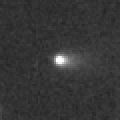
|
It brightened very rapidly. Now it is 11.3 mag (June 2, Bob King). It will fade out rapidly after this. It locates somewhat low in the Northern Hemisphere. In the Southern Hemisphere, it is not observable now, but it will appear in August.
Date(TT) R.A. (2000) Decl. Delta r Elong. m1 Best Time(A, h)
June 1 5 7.64 48 17.1 1.927 1.122 26 11.2 20:52 (147, 7)
June 8 5 41.92 52 16.2 1.885 1.130 30 11.2 20:58 (150, 10)
|

|
First return of a new periodic comet which was discovered in 2011, half a year after the perihelion passage. It brightened very rapidly. Now it is 10.8 mag (May 6, Juan Jose Gonzalez). It will fade out rapidly after this. It will be fainter than 18 mag in September. It stays extremely low in the Northern Hemisphere. In the Southern Hemisphere, it stays observable in good condition.
Date(TT) R.A. (2000) Decl. Delta r Elong. m1 Best Time(A, h)
June 1 10 41.04 -24 32.6 0.649 1.295 99 11.4 20:52 ( 40, 18)
June 8 11 13.10 -26 12.1 0.672 1.325 101 11.7 20:58 ( 39, 16)
|

|
It has not been observed yet in this apparition. It will fade out rapidly after this. It locates somewhat low in the Northern Hemisphere. But it will become high in autumn. It stays extremely low in the Southern Hemisphere. It brightens up to 11.5 mag in early summer. But it locates very low around the high light.
Date(TT) R.A. (2000) Decl. Delta r Elong. m1 Best Time(A, h)
June 1 2 23.06 22 2.2 2.341 1.560 30 11.5 3:03 (246, 5)
June 8 2 44.47 24 27.7 2.317 1.554 32 11.4 3:00 (245, 7)
|
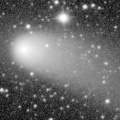
|
It brightened up to 9.6 mag from February to March (Feb. 25, Thomas Lehmann). Now it is 12.3 mag (May 29, Osamu Miyazaki). Fading gradually. In the Northern Hemisphere, it stays observable in good condition. In the Southern Hemisphere, it is not observable now, but it will appear in September.
Date(TT) R.A. (2000) Decl. Delta r Elong. m1 Best Time(A, h)
June 1 20 36.52 56 34.1 1.812 2.025 86 11.9 3:03 (199, 67)
June 8 20 34.47 58 34.8 1.872 2.096 87 12.1 3:00 (189, 66)
|
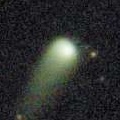
|
Now it is 12.5 mag (May 12, W. Pei). It stays 12 mag for a while. In the Northern Hemisphere, it will be unobservable soon. But it will be observable again in July. In the Southern Hemisphere, it is not observable now.
Date(TT) R.A. (2000) Decl. Delta r Elong. m1 Best Time(A, h)
June 1 6 54.10 34 38.0 4.600 3.785 32 12.7 20:52 (124, 12)
June 8 6 56.52 35 6.6 4.645 3.770 27 12.7 20:58 (128, 8)
|

|
It is expected to brighten up to 12.5 mag in summer. Now it is 14.0 mag (May 29, Chris Wyatt). It stays 13 mag for a while. In the Northern Hemisphere, it is not observable now, but it will appear in August. In the Southern Hemisphere, it stays observable in good condition. Around the high light, it is observable in good condition in the Southern Hemisphere, but it locates very low in the Northern Hemisphere.
Date(TT) R.A. (2000) Decl. Delta r Elong. m1 Best Time(A, h)
June 1 15 55.94 -77 2.8 2.306 3.002 124 13.6 23:15 ( 0,-22)
June 8 15 42.81 -76 0.3 2.246 2.957 125 13.5 22:35 ( 0,-21)
|

|
Now it is 13.8 mag (May 28, Chris Wyatt). It stays 14 mag for a while. In the Northern Hemisphere, it will be unobservable in August. In the Southern Hemisphere, it stays observable in good condition.
Date(TT) R.A. (2000) Decl. Delta r Elong. m1 Best Time(A, h)
June 1 11 55.33 -25 55.4 4.507 5.042 116 13.8 20:52 ( 24, 25)
June 8 11 57.64 -24 54.2 4.585 5.034 110 13.8 20:58 ( 32, 23)
|
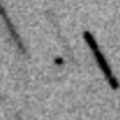
|
Brightening gradually. Now it is not observable. It will appear in September in the Northern Hemisphere. In the Southern Hemisphere, it will never be observable after this. It brightens up to 11 mag in August. But it is not observable around the high light.
Date(TT) R.A. (2000) Decl. Delta r Elong. m1 Best Time(A, h)
June 1 5 17.26 4 49.5 2.442 1.528 19 14.3 20:52 (115,-24)
June 8 5 38.01 5 21.0 2.360 1.440 19 13.9 20:58 (118,-26)
|

|
It was observed at 9-10 mag for a long time in 2023. Now it is 13.3 mag (May 20, Thomas Lehmann). Fading slowly. In the Northern Hemisphere, it will never be observable after this. In the Southern Hemisphere, it stays observable in good condition.
Date(TT) R.A. (2000) Decl. Delta r Elong. m1 Best Time(A, h)
June 1 0 38.11 -48 58.8 4.575 4.661 88 14.0 3:03 (319,-17)
June 8 0 39.49 -50 35.9 4.541 4.718 93 14.0 3:00 (322,-14)
|

|
Now it is 15.2 mag (May 17, ATLAS-MLO, Mauna Loa). It will be unobservable in July. But it will be observable again in September.
Date(TT) R.A. (2000) Decl. Delta r Elong. m1 Best Time(A, h)
June 1 8 24.75 19 27.0 6.760 6.206 53 14.1 20:52 ( 99, 21)
June 8 8 28.91 19 8.5 6.848 6.207 47 14.1 20:58 (103, 15)
|
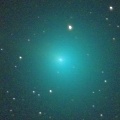
|
It brightened up to 8.9 mag from January to March (Feb. 13, Chris Wyatt). Now it is 13.7 mag (May 7, Chris Wyatt). Fading rapidly. It will be fainter than 18 mag in August. It locates somewhat low in the Northern Hemisphere. In the Southern Hemisphere, it stays observable in good condition.
Date(TT) R.A. (2000) Decl. Delta r Elong. m1 Best Time(A, h)
June 1 9 44.46 9 44.8 1.987 1.973 74 14.2 20:52 ( 78, 32)
June 8 9 59.39 8 36.7 2.099 2.023 71 14.6 20:58 ( 80, 28)
|

|
Now it is 14.4 mag (May 26, Thomas Lehmann). Fading slowly. In the Northern Hemisphere, it will be unobservable soon. In the Southern Hemisphere, it will be getting lower gradually. But it will be getting higher again after August.
Date(TT) R.A. (2000) Decl. Delta r Elong. m1 Best Time(A, h)
June 1 9 55.73 -25 57.2 2.615 2.822 91 14.3 20:52 ( 48, 10)
June 8 9 50.75 -24 50.6 2.764 2.844 84 14.5 20:58 ( 55, 5)
|
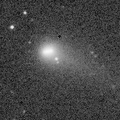
|
Now it is 14.0 mag (May 8, Thomas Lehmann). Fading slowly. It will be unobservable in July.
Date(TT) R.A. (2000) Decl. Delta r Elong. m1 Best Time(A, h)
June 1 7 24.75 29 7.5 2.754 2.058 38 14.6 20:52 (115, 15)
June 8 7 43.04 28 29.5 2.806 2.071 35 14.7 20:58 (117, 12)
|

|
It brightened up to 8 mag from 2022 summer to 2023 spring. Now it is 14.5 mag (Apr. 27, Hiroshi Abe). It stays 15 mag for a while. Now it is not observable. It will appear in July.
Date(TT) R.A. (2000) Decl. Delta r Elong. m1 Best Time(A, h)
June 1 5 40.68 14 11.2 6.882 5.921 17 14.9 20:52 (118,-13)
June 8 5 44.73 14 33.2 6.966 5.979 12 15.0 20:58 (124,-18)
|

|
It brightened up to 8.3 mag in 2021-2022 winter (Jan. 6, 2022, Toshiyuki Takahashi). Now it is 16.3 mag (May 23, ATLAS South Africa). It stays 16 mag for a while. In the Northern Hemisphere, it will never be observable after this. In the Southern Hemisphere, it stays observable in good condition.
Date(TT) R.A. (2000) Decl. Delta r Elong. m1 Best Time(A, h)
June 1 10 38.31 -48 42.0 7.659 8.010 106 15.2 20:52 ( 27, -2)
June 8 10 40.23 -48 12.4 7.767 8.055 102 15.2 20:58 ( 32, -5)
|
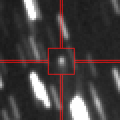
|
It brightened very rapidly in outburst in late May. Now it is 15.1 mag (May 28, ATLAS Chile). Fading slowly. It locates somewhat low in the Northern Hemisphere. In the Southern Hemisphere, it stays observable in good condition.
Date(TT) R.A. (2000) Decl. Delta r Elong. m1 Best Time(A, h)
June 1 15 34.84 -27 5.7 2.170 3.161 165 15.2 22:53 ( 0, 28)
June 8 15 30.90 -26 27.3 2.197 3.163 158 15.2 22:22 ( 0, 29)
|
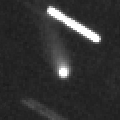
|
Now it is 16.1 mag (Feb. 22, ATLAS Chile). It stays 15 mag for a while. In the Northern Hemisphere, it is not observable now. The brightness evolution is slower than originally expected.
Date(TT) R.A. (2000) Decl. Delta r Elong. m1 Best Time(A, h)
June 1 3 52.09 -40 16.6 3.113 2.806 63 15.3 3:03 (294,-45)
June 8 4 7.01 -42 4.4 3.043 2.794 66 15.2 3:00 (297,-44)
|

|
Now it is 14.9 mag (May 27, ATLAS South Africa). It stays 16 mag for a while. In the Northern Hemisphere, it will be getting higher gradually. In the Southern Hemisphere, it stays observable in good condition.
Date(TT) R.A. (2000) Decl. Delta r Elong. m1 Best Time(A, h)
June 1 0 37.18 -1 52.2 2.095 1.868 62 15.2 3:03 (281, 12)
June 8 0 51.35 -0 31.6 2.052 1.881 65 15.2 3:00 (281, 15)
|

|
Now it is 14.8 mag (May 19, ATLAS Chile). It stays 16 mag for a while. In the Northern Hemisphere, it is not observable now, but it will appear in September. In the Southern Hemisphere, it will be getting lower gradually. But it will be getting higher again after July.
Date(TT) R.A. (2000) Decl. Delta r Elong. m1 Best Time(A, h)
June 1 7 24.28 -32 30.8 5.506 5.207 67 15.3 20:52 ( 63,-20)
June 8 7 26.19 -32 12.6 5.604 5.249 64 15.3 20:58 ( 67,-25)
|

|
Alan Hale reported its cometary appearance. Now it is 15 mag (May 26, Hidetaka Sato). Fading gradually. It will be unobservable in July in the Northern Hemisphere, or in September in the Southern Hemisphere.
Date(TT) R.A. (2000) Decl. Delta r Elong. m1 Best Time(A, h)
June 1 7 59.71 19 18.4 2.101 1.600 47 15.3 20:52 (102, 16)
June 8 8 20.58 18 13.1 2.140 1.607 45 15.4 20:58 (103, 13)
|

|
It has not been observed yet in this apparition. It is expected to brighten up to 15 mag in summer. Fading slowly. In the Northern Hemisphere, it is not observable now, but it will be observable soon. It stays extremely low in the Southern Hemisphere.
Date(TT) R.A. (2000) Decl. Delta r Elong. m1 Best Time(A, h)
June 1 2 31.42 3 37.4 2.171 1.468 35 15.5 3:03 (260, -8)
June 8 2 50.69 6 17.9 2.165 1.476 36 15.3 3:00 (258, -5)
|

|
It will brighten up to 14 mag from summer to autumn. Now it is 16.3 mag (May 27, ATLAS Chile). Brightening slowly. It locates somewhat low in the Northern Hemisphere. In the Southern Hemisphere, it stays observable in good condition. Around the high light, it is observable in good condition in the Southern Hemisphere. But it locates extremely low in the Northern Hemisphere.
Date(TT) R.A. (2000) Decl. Delta r Elong. m1 Best Time(A, h)
June 1 12 25.49 -17 48.5 1.325 2.044 121 15.6 20:52 ( 20, 35)
June 8 12 27.78 -17 31.9 1.352 2.007 115 15.4 20:58 ( 28, 32)
|
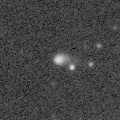
|
Now it is 15.9 mag (Mar. 26, ATLAS Chile). It stays 15 mag for a while. Now it is not observable. It will appear soon in the Southern Hemisphere, or in August in the Northern Hemisphere.
Date(TT) R.A. (2000) Decl. Delta r Elong. m1 Best Time(A, h)
June 1 5 21.41 1 28.0 7.359 6.440 23 15.7 20:52 (112,-25)
June 8 5 26.70 1 49.8 7.347 6.414 21 15.6 20:58 (117,-30)
|
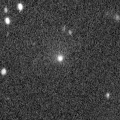
|
Very large comet. It is expected to brighten up to 13 mag in 2031. Now it is 15.0 mag (May 3, Thomas Lehmann). It stays 16 mag for a while. In the Northern Hemisphere, it is not observable now. In the Southern Hemisphere, it stays observable in good condition. In the Northern Hemisphere, it is not observable until 2030.
Date(TT) R.A. (2000) Decl. Delta r Elong. m1 Best Time(A, h)
June 1 3 41.65 -61 37.6 16.388 16.320 84 15.7 3:03 (325,-44)
June 8 3 45.72 -61 47.9 16.333 16.295 86 15.7 3:00 (325,-42)
|
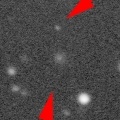
|
It is expected to brighten up to 13 mag in 2025 autumn, and it will be observable in good condition. Now it is 15.9 mag (May 24, Ken-ichi Kadota). Brightening slowly. It stays observable in good condition.
Date(TT) R.A. (2000) Decl. Delta r Elong. m1 Best Time(A, h)
June 1 22 55.40 -5 36.3 5.218 5.275 87 15.8 3:03 (301, 29)
June 8 22 58.12 -5 13.6 5.073 5.237 93 15.7 3:00 (306, 33)
|

|
It will brighten up to 14.5 mag in summer. Now it is 16.7 mag (May 29, ATLAS South Africa). Brightening slowly. It locates somewhat low in the Northern Hemisphere. But it will become high in summer. In the Southern Hemisphere, it stays observable in good condition.
Date(TT) R.A. (2000) Decl. Delta r Elong. m1 Best Time(A, h)
June 1 0 52.61 -18 21.2 1.680 1.605 67 16.2 3:03 (292, -1)
June 8 1 13.78 -16 18.0 1.620 1.570 68 15.9 3:00 (291, 1)
|
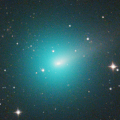
|
It brightened up to 7.4 mag from December to January (Dec. 24, Osamu Miyazaki). Now it is 14.7 mag (May 27, Thomas Lehmann). Fading rapidly. It will be fainter than 18 mag in July. In the Northern Hemisphere, it will be getting lower gradually. In the Southern Hemisphere, it stays observable in good condition.
Date(TT) R.A. (2000) Decl. Delta r Elong. m1 Best Time(A, h)
June 1 12 22.03 2 9.3 1.529 2.145 113 16.0 20:52 ( 30, 53)
June 8 12 28.10 1 4.0 1.652 2.197 108 16.4 20:58 ( 39, 49)
|
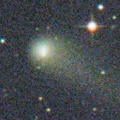
|
It brightened up to 11.1 mag in early 2022 (Mar. 31, 2022, F. Kugel, J.-G. Bosch, J. Nicolas). Now it is 15.9 mag (May 26, Ken-ichi Kadota). Fading slowly. In the Northern Hemisphere, it stays observable in good condition. It locates somewhat low in the Southern Hemisphere.
Date(TT) R.A. (2000) Decl. Delta r Elong. m1 Best Time(A, h)
June 1 17 34.90 32 39.1 6.484 7.095 123 16.0 0:57 ( 0, 88)
June 8 17 31.92 32 55.9 6.520 7.136 123 16.0 0:26 ( 0, 88)
|
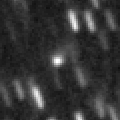
|
Now it is 16.3 mag (May 21, Jean-Claude Merlin). It stays 16 mag for a while. In the Northern Hemisphere, it will be unobservable in July. In the Southern Hemisphere, it stays observable in good condition.
Date(TT) R.A. (2000) Decl. Delta r Elong. m1 Best Time(A, h)
June 1 14 32.71 -50 55.5 4.674 5.513 142 16.3 21:51 ( 0, 4)
June 8 14 20.08 -50 3.9 4.700 5.496 137 16.3 21:11 ( 0, 5)
|

|
It brightened up to 12.1 mag in 2023 spring (May 20, 2023, Jose Guilherme de S. Aguiar). Now it is 15.8 mag (May 17, ATLAS Chile). It stays 17 mag for a while. In the Northern Hemisphere, it is not observable now, but it will appear in September. It locates somewhat low in the Southern Hemisphere. But it will become high in summer.
Date(TT) R.A. (2000) Decl. Delta r Elong. m1 Best Time(A, h)
June 1 5 45.32 -39 7.7 5.134 4.764 63 16.3 20:52 ( 66,-41)
June 8 5 52.38 -38 15.3 5.202 4.811 62 16.3 20:58 ( 69,-45)
|

|
Now it is 16.3 mag (May 24, ATLAS-MLO, Mauna Loa). Fading gradually. It will be fainter than 18 mag in July. It stays observable in good condition.
Date(TT) R.A. (2000) Decl. Delta r Elong. m1 Best Time(A, h)
June 1 21 37.88 -3 35.4 1.177 1.740 104 16.6 3:03 (319, 43)
June 8 21 44.28 -3 17.6 1.147 1.772 109 16.9 3:00 (324, 45)
|

|
Now it is 16.4 mag (May 26, ATLAS South Africa). It stays 17 mag for a while. In the Northern Hemisphere, it will be getting lower gradually after this, and it will be unobservable in September. In the Southern Hemisphere, it stays observable in good condition.
Date(TT) R.A. (2000) Decl. Delta r Elong. m1 Best Time(A, h)
June 1 12 32.09 4 20.3 2.878 3.429 114 16.6 20:52 ( 28, 56)
June 8 12 32.60 3 52.5 2.954 3.414 108 16.7 20:58 ( 40, 52)
|
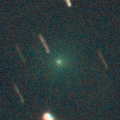
|
First return of a new periodic comet which brightened up to 10 mag in 2001. It brightened up to 12.5 mag from February to March (Feb. 29, Thomas Lehmann). Now it is 14.9 mag (May 28, Thomas Lehmann). Fading rapidly. It will be fainter than 18 mag soon. It locates somewhat low in the Northern Hemisphere. In the Southern Hemisphere, it will never be observable after this.
Date(TT) R.A. (2000) Decl. Delta r Elong. m1 Best Time(A, h)
June 1 7 51.67 62 32.0 2.303 1.861 52 16.7 20:52 (147, 33)
June 8 8 30.86 60 14.0 2.375 1.916 51 17.2 20:58 (144, 33)
|

|
It will brighten up to 16 mag in summer. Now it is 16.8 mag (May 29, ATLAS South Africa). It stays 17 mag for a while. In the Northern Hemisphere, it will be getting higher gradually. In the Southern Hemisphere, it stays observable in good condition.
Date(TT) R.A. (2000) Decl. Delta r Elong. m1 Best Time(A, h)
June 1 23 15.02 -19 20.2 2.059 2.275 88 16.8 3:03 (308, 16)
June 8 23 24.25 -18 52.7 1.995 2.286 93 16.7 3:00 (310, 19)
|
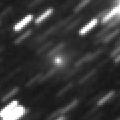
|
Very far object. Now it is 17.1 mag (Apr. 2, ATLAS Chile). It stays 17 mag for a while. In the Northern Hemisphere, it is not observable now. In the Southern Hemisphere, it stays observable in good condition.
Date(TT) R.A. (2000) Decl. Delta r Elong. m1 Best Time(A, h)
June 1 2 52.50 -63 8.0 10.360 10.368 87 16.7 3:03 (326,-39)
June 8 2 55.24 -63 15.1 10.325 10.371 89 16.7 3:00 (327,-36)
|
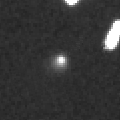
|
Now it is 16.5 mag (May 12, ATLAS South Africa). It stays 17 mag for a while. In the Northern Hemisphere, it is not observable now, but it will appear in August. It locates somewhat low in the Southern Hemisphere. But it will become high in summer.
Date(TT) R.A. (2000) Decl. Delta r Elong. m1 Best Time(A, h)
June 1 5 41.37 -25 1.1 7.839 7.224 49 16.9 20:52 ( 83,-36)
June 8 5 46.89 -24 40.6 7.836 7.205 48 16.8 20:58 ( 87,-42)
|

|
It brightened up to 14 mag in early 2023 and 2023 autumn. Now it is 16.7 mag (May 25, ATLAS-MLO, Mauna Loa). It stays 17 mag for a while. It stays observable in good condition.
Date(TT) R.A. (2000) Decl. Delta r Elong. m1 Best Time(A, h)
June 1 22 38.98 19 8.8 4.728 4.702 82 16.9 3:03 (280, 48)
June 8 22 34.72 19 55.3 4.654 4.746 88 16.9 3:00 (285, 54)
|

|
Now it is 17.6 mag (Mar. 20, ATLAS South Africa). It stays 17 mag for a while. It stays observable in good condition.
Date(TT) R.A. (2000) Decl. Delta r Elong. m1 Best Time(A, h)
June 1 15 6.78 -1 30.0 1.955 2.878 150 16.9 22:25 ( 0, 53)
June 8 15 3.89 -1 9.1 1.995 2.875 143 16.9 21:55 ( 0, 54)
|

|
Now it is 16.9 mag (May 28, ATLAS Chile). Fading slowly. It will be fainter than 18 mag in August. In the Southern Hemisphere, it stays observable in good condition.
Date(TT) R.A. (2000) Decl. Delta r Elong. m1 Best Time(A, h)
June 1 14 0.67 -19 30.6 2.710 3.578 143 17.1 21:20 ( 0, 35)
June 8 14 1.20 -18 39.9 2.786 3.596 136 17.2 20:58 ( 1, 36)
|

|
Now it is 16.8 mag (May 18, ATLAS South Africa). It stays 17 mag for a while. It will be unobservable soon in the Northern Hemisphere, or in August in the Southern Hemisphere. But it will be observable again in September in the Southern Hemisphere.
Date(TT) R.A. (2000) Decl. Delta r Elong. m1 Best Time(A, h)
June 1 8 21.89 -5 27.7 4.529 4.144 61 17.2 20:52 ( 78, 7)
June 8 8 28.75 -5 33.8 4.572 4.113 57 17.1 20:58 ( 82, 1)
|

|
Now it is 17.3 mag (May 13, A. Diepvens). It stays 17 mag for a while. It will be getting lower gradually after this, and it will be unobservable in August. But it will be observable again in September in the Northern Hemisphere.
Date(TT) R.A. (2000) Decl. Delta r Elong. m1 Best Time(A, h)
June 1 10 10.21 18 57.8 5.503 5.370 77 17.2 20:52 ( 84, 43)
June 8 10 11.63 19 23.4 5.585 5.337 70 17.1 20:58 ( 89, 36)
|

|
Now it is 17.1 mag (May 27, ATLAS Chile). It stays 17 mag for a while. In the Northern Hemisphere, it is not observable now, but it will appear in September. It locates somewhat low in the Southern Hemisphere. But it will become high in autumn. It stays 15 mag for a long time from late 2024 to early 2026.
Date(TT) R.A. (2000) Decl. Delta r Elong. m1 Best Time(A, h)
June 1 6 41.96 -33 45.7 5.412 5.039 63 17.2 20:52 ( 67,-28)
June 8 6 47.75 -32 35.6 5.422 5.002 60 17.2 20:58 ( 71,-33)
|
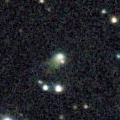
|
It brightened up to 14.5 mag from February to March (Mar. 11, W. Pei). Now it is 16.0 mag (May 13, A. Diepvens). It will fade out rapidly after this. It will be fainter than 18 mag soon. In the Northern Hemisphere, it will be getting lower gradually. In the Southern Hemisphere, it stays observable in good condition.
Date(TT) R.A. (2000) Decl. Delta r Elong. m1 Best Time(A, h)
June 1 10 33.20 13 24.5 1.611 1.817 84 17.2 20:52 ( 73, 44)
June 8 10 47.64 11 23.2 1.697 1.847 81 17.5 20:58 ( 74, 39)
|

|
Now it is 17.0 mag (May 29, ATLAS-HKO, Haleakala). It stays 17 mag for a while. In the Northern Hemisphere, it stays observable in good condition. It stays extremely low in the Southern Hemisphere.
Date(TT) R.A. (2000) Decl. Delta r Elong. m1 Best Time(A, h)
June 1 22 33.47 45 44.7 4.390 4.240 74 17.5 3:03 (238, 56)
June 8 22 26.40 46 38.5 4.307 4.248 79 17.5 3:00 (235, 61)
|

|
It approaches to Sun down to 0.09 a.u. on Jan. 13, 2025. According to the calculation, it will brighten up to -1 mag. But probably, it will be disintegrated. At the high light, it may be observable after the perihelion passage only in the Southern Hemisphere. Now it is 17.2 mag (May 27, ATLAS South Africa). Brightening gradually. In the Northern Hemisphere, it will never be observable after this. In the Southern Hemisphere, it stays observable in good condition.
Date(TT) R.A. (2000) Decl. Delta r Elong. m1 Best Time(A, h)
June 1 14 30.48 -79 21.0 3.378 3.996 120 17.7 21:48 ( 0,-24)
June 8 13 55.13 -77 59.5 3.296 3.912 120 17.5 20:58 ( 1,-23)
|

|
Fading slowly. It will be fainter than 18 mag in July. It stays observable in good condition.
Date(TT) R.A. (2000) Decl. Delta r Elong. m1 Best Time(A, h)
June 1 19 5.56 -4 8.2 2.376 3.217 139 18.0 2:28 ( 0, 51)
June 8 18 53.93 -6 11.7 2.300 3.213 148 17.9 1:49 ( 0, 49)
|

|
It was observed at three apparitions in 2003, 2012 and 2016. It has not been observed yet in this apparition. It will brighten up to 15.5 mag in July. It brightens up to 15.5 mag, but it will turn to fade out rapidly after that. It will be unobservable soon in the Northern Hemisphere, or in July in the Southern Hemisphere.
Date(TT) R.A. (2000) Decl. Delta r Elong. m1 Best Time(A, h)
June 1 1 20.53 13 23.7 1.104 0.852 47 19.0 3:03 (262, 12)
June 8 2 8.60 15 57.9 1.113 0.769 42 17.9 3:00 (257, 9)
|
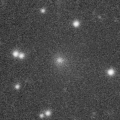
|
Now it is 16.1 mag (May 12, Thomas Lehmann). It will fade out rapidly after this. In the Northern Hemisphere, it stays observable in good condition. It stays extremely low in the Southern Hemisphere.
Date(TT) R.A. (2000) Decl. Delta r Elong. m1 Best Time(A, h)
June 1 14 50.28 35 33.4 1.557 2.212 117 17.9 22:08 (180, 89)
June 8 14 42.30 36 36.5 1.699 2.278 111 18.2 21:33 (180, 88)
|
|
![]()
 C/2021 S3 ( PanSTARRS )
C/2021 S3 ( PanSTARRS ) C/2022 E2 ( ATLAS )
C/2022 E2 ( ATLAS ) C/2023 C2 ( ATLAS )
C/2023 C2 ( ATLAS ) C/2021 G2 ( ATLAS )
C/2021 G2 ( ATLAS ) C/2023 R2 ( PanSTARRS )
C/2023 R2 ( PanSTARRS ) C/2020 V2 ( ZTF )
C/2020 V2 ( ZTF ) 29P/Schwassmann-Wachmann 1
29P/Schwassmann-Wachmann 1 144P/Kushida
144P/Kushida C/2022 L2 ( ATLAS )
C/2022 L2 ( ATLAS ) 32P/Comas Sola
32P/Comas Sola C/2017 K2 ( PanSTARRS )
C/2017 K2 ( PanSTARRS ) C/2019 L3 ( ATLAS )
C/2019 L3 ( ATLAS ) 299P/Catalina-PanSTARRS
299P/Catalina-PanSTARRS C/2022 S4 ( Lemmon )
C/2022 S4 ( Lemmon ) 130P/McNaught-Hughes
130P/McNaught-Hughes C/2019 U5 ( PanSTARRS )
C/2019 U5 ( PanSTARRS ) 2024 FG9
2024 FG9 192P/Shoemaker-Levy 1
192P/Shoemaker-Levy 1 37P/Forbes
37P/Forbes C/2022 QE78 ( ATLAS )
C/2022 QE78 ( ATLAS ) C/2014 UN271 ( Bernardinelli-Bernstein )
C/2014 UN271 ( Bernardinelli-Bernstein ) C/2022 N2 ( PanSTARRS )
C/2022 N2 ( PanSTARRS ) 146P/Shoemaker-LINEAR
146P/Shoemaker-LINEAR 62P/Tsuchinshan 1
62P/Tsuchinshan 1 C/2019 T4 ( ATLAS )
C/2019 T4 ( ATLAS ) C/2023 F3 ( ATLAS )
C/2023 F3 ( ATLAS ) C/2020 K1 ( PanSTARRS )
C/2020 K1 ( PanSTARRS ) 125P/Spacewatch
125P/Spacewatch 65P/Gunn
65P/Gunn 473P/2023 W1 ( NEAT )
473P/2023 W1 ( NEAT ) 89P/Russell 2
89P/Russell 2 C/2019 E3 ( ATLAS )
C/2019 E3 ( ATLAS ) C/2022 R6 ( PanSTARRS )
C/2022 R6 ( PanSTARRS ) C/2021 X1 ( Maury-Attard )
C/2021 X1 ( Maury-Attard ) 362P/(457175) 2008 GO98
362P/(457175) 2008 GO98 C/2022 T1 ( Lemmon )
C/2022 T1 ( Lemmon ) C/2023 T3 ( Fuls )
C/2023 T3 ( Fuls ) C/2023 H5 ( Lemmon )
C/2023 H5 ( Lemmon ) C/2024 A1 ( ATLAS )
C/2024 A1 ( ATLAS ) 227P/Catalina-LINEAR
227P/Catalina-LINEAR C/2022 U1 ( Leonard )
C/2022 U1 ( Leonard ) C/2024 G3 ( ATLAS )
C/2024 G3 ( ATLAS ) C/2023 Q2 ( PanSTARRS )
C/2023 Q2 ( PanSTARRS ) P/2003 T12 ( SOHO )
P/2003 T12 ( SOHO ) C/2024 C4 ( ATLAS )
C/2024 C4 ( ATLAS )![]()















































